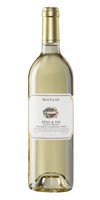A wine affected by changes in climate, both micro and economic: Maculan Pino & Toi 2004

This is a Soave-type wine that gets no shortage of press online. Even though it receives an I.G.T. classification (aligning it with the often unheralded regional country wines of Italy) its maker, Maculan, needs no formal designation to please its clientele. Maculan chooses to avoid the official label of Soave in order to blend three disallowed white grape varieties in unique proportions (more on that below).
To me, Maculan has achieved much more affordable elegance in doing this. The Maculan Pino & Toi 2004, cheaper than most quality Soaves, is deliciously fragrant apple cut by deeply-etched minerality. This is my favourite kind of white wine. On the nose it possesses wet stone with wonderful aromatics. Delicate and light on the palate but strangely steely and structured too.
With a shrimp, crab and mussel pizza, the drink is tonic. The fruit suffers a little bit though, masked by the presence of the tomato sauce. With homemade chicken and pasta soup, the wine has even more of a chance to reveal its full range of sophistication. Serving it like the Fiche descriptive says with Vol-au-vent au poulet (click on the bottle image) would be right on the money.
I'm not going to so much contradict Basic Juice's profile of this wine as much as I am going to update it. I was quite interested in reading his review of the 2002 and seeing that market value was an issue for him. Two vintages later, the Euro has weakened drastically, making this bottle available in Canada for $16.70 instead of $17.80 or even more than that back in 2004. In terms of acidity, I believe the current vintage (and the 2003 one as well) is a much more balanced wine than the 2002 was. Jameson tipped me off on the 2004 vintage being something of an apogee and I'd have to agree him. In fact, on occasion during the past year, my friends and I have thought Pino & Toi's current blend (Pinot Bianco and Pinot Grigio mixed into a majority of Tocai) can produce plenty of gripping acidity, something that attracts me more to a white wine than it repels me.
I'm not sure if the blending has changed or if the climate working alone has been enough to present these tangible effects on the acid in the finished product. Because 2002 was notably weak in Northern Italy, I'm guessing this wine is playing its strong card now because of the favourable 2004 vintage. Take advantage of it.
Breganze, Veneto, Italia. 12%.







1 comment:
I've never tried either of these wines. Thanks for the tips and the great tasting notes.
I can't wait to give these wines a try, especially with summer on the way.
Post a Comment